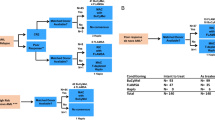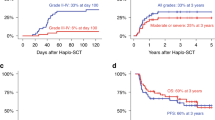Abstract
The clinical use of autologous marrow transplantation in acute myeloid leukemia (AML) has been hampered by the inability to collect adequate numbers of cells after remission induction chemotherapy and the notably delayed hematopoietic regeneration following autograft reinfusion. Here we present a study in which the feasibility of mobilizing stem cells was investigated in newly diagnosed AML. Among 96 AML patients, 76 patients (79%) entered complete remission. Mobilization was undertaken with low dose and high dose schedules of G-CSF in 63 patients, and 54 patients (87%) were leukapheresed. A median of 2.0 × 106 CD34+cells/kg (range 0.1–72.0) was obtained in a median of three leukaphereses following a low dose G-CSF schedule (150 μg/m2) during an average of 20 days. Higher dose regimens of G-CSF (450 μg/m2 and 600 μg/m2) given during an average of 11 days resulted in 28 patients in a yield of 3.6 × 106 CD34+ cells/kg (range 0–60.3) also obtained following three leukaphereses. The low dose and high dose schedules of G-CSF permitted the collection of 2 × 106 CD34-positive cells in 46% and 79% of cases respectively (P = 0.01). Twenty-eight patients were transplanted with a peripheral blood stem cell (PBSC) graft and hemopoietic repopulation was compared with the results of a previous study with autologous bone marrow. Recovery of granulocytes (>0.5 × 109/l, 17 vs 37 days) and platelets (>20 × 109/l; 26 vs 96 days) was significantly faster after peripheral stem cell transplantation compared to autologous bone marrow transplantation. These results demonstrate the feasibility of PBSCT in the majority of cases with AML and the potential advantage of this approach with respect to hemopoietic recovery.
This is a preview of subscription content, access via your institution
Access options
Subscribe to this journal
Receive 12 print issues and online access
$259.00 per year
only $21.58 per issue
Buy this article
- Purchase on Springer Link
- Instant access to full article PDF
Prices may be subject to local taxes which are calculated during checkout
Similar content being viewed by others
Author information
Authors and Affiliations
Rights and permissions
About this article
Cite this article
Vellenga, E., van Putten, W., Boogaerts, M. et al. Peripheral blood stem cell transplantation as an alternative to autologous marrow transplantation in the treatment of acute myeloid leukemia?. Bone Marrow Transplant 23, 1279–1282 (1999). https://doi.org/10.1038/sj.bmt.1701799
Received:
Accepted:
Published:
Issue Date:
DOI: https://doi.org/10.1038/sj.bmt.1701799
Keywords
This article is cited by
-
Comparable outcomes between autologous and allogeneic transplant for adult acute myeloid leukemia in first CR
Bone Marrow Transplantation (2016)
-
High numbers of mobilized CD34+ cells collected in AML in first remission are associated with high relapse risk irrespective of treatment with autologous peripheral blood SCT or autologous BMT
Bone Marrow Transplantation (2015)
-
Differential role for very late antigen-5 in mobilization and homing of hematopoietic stem cells
Bone Marrow Transplantation (2006)
-
MRD parameters using immunophenotypic detection methods are highly reliable in predicting survival in acute myeloid leukaemia
Leukemia (2004)
-
High percentage of CD34-positive cells in autologous AML peripheral blood stem cell products reflects inadequate in vivo purging and low chemotherapeutic toxicity in a subgroup of patients with poor clinical outcome
Leukemia (2003)



